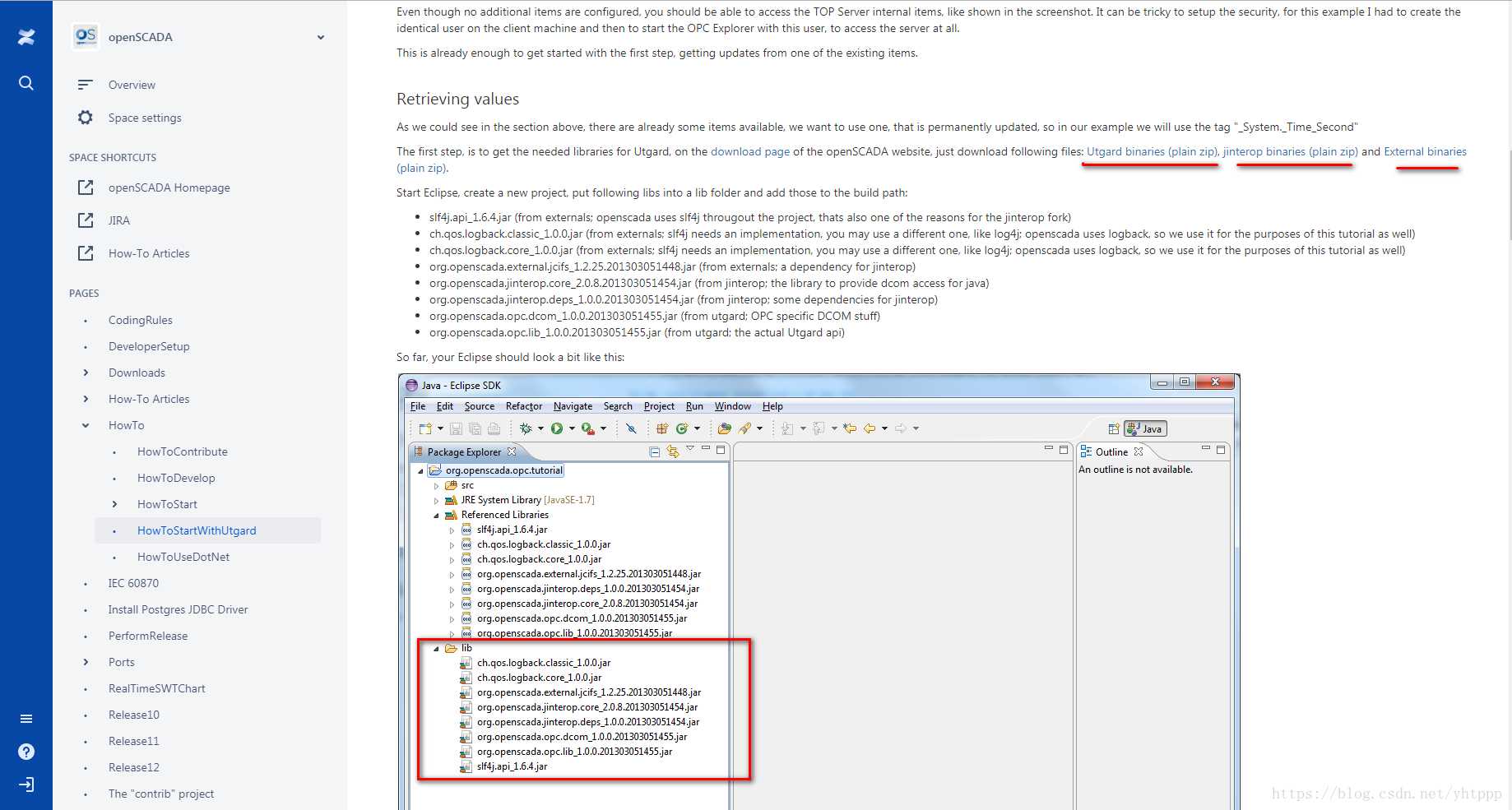Java实现OPC通信---utgard
Posted frankie1980
tags:
篇首语:本文由小常识网(cha138.com)小编为大家整理,主要介绍了Java实现OPC通信---utgard相关的知识,希望对你有一定的参考价值。
一.OPC
1.使用的OPC server软件:
模拟仿真用的 MatrikonOPCSimulation(50M),https://pan.baidu.com/share/init?surl=9rcHEBGSWGMSkRo1kEY6fQ,密码: mcur
项目使用KEPServer V6(450M,中文),https://pan.baidu.com/share/init?surl=3Bc0gfGxCWo8fddTt-ut-w,密码: ykj2
推荐使用KEPServer V6,配置DCOM步骤清晰。
2.使用OPC server软件:
MatrikonOPCSimulation:https://www.cnblogs.com/ioufev/p/9366426.html
KEPServer V6:https://www.cnblogs.com/ioufev/p/9366877.html
3.配置Server和Client:
OPC和DCOM配置:https://www.cnblogs.com/ioufev/p/9365919.html
注:1.使用 MatrikonOPCSimulation,要额外下载OPC运行库。
2. 创建用户时,电脑管理内无“本地用户和组”,原因为:Windows版本为家庭版,升级Windows版本为企业版或专业版。
3.在配置组件服务时,无创建的用户时,可以通过添加得到。
二.编写OPC Client
下载添加jar包,https://pan.baidu.com/s/1MLynD_iYceWpWxVIQ0e7Pw ,密码: ermn,可以从此项目找到所有jar包。
 读取数据
读取数据
import java.util.concurrent.Executors; import org.jinterop.dcom.common.JIException; import org.jinterop.dcom.core.JIString; import org.jinterop.dcom.core.JIVariant; import org.openscada.opc.lib.common.ConnectionInformation; import org.openscada.opc.lib.da.AccessBase; import org.openscada.opc.lib.da.DataCallback; import org.openscada.opc.lib.da.Item; import org.openscada.opc.lib.da.ItemState; import org.openscada.opc.lib.da.Server; import org.openscada.opc.lib.da.SyncAccess; public class UtgardTutorial1 { public static void main(String[] args) throws Exception { // 连接信息 final ConnectionInformation ci = new ConnectionInformation(); ci.setHost("192.168.0.1"); // 电脑IP ci.setDomain(""); // 域,为空就行 ci.setUser("OPCUser"); // 电脑上自己建好的用户名 ci.setPassword("123456"); // 用户名的密码 // 使用MatrikonOPC Server的配置 // ci.setClsid("F8582CF2-88FB-11D0-B850-00C0F0104305"); // MatrikonOPC的注册表ID,可以在“组件服务”里看到 // final String itemId = "u.u"; // 项的名字按实际 // 使用KEPServer的配置 ci.setClsid("7BC0CC8E-482C-47CA-ABDC-0FE7F9C6E729"); // KEPServer的注册表ID,可以在“组件服务”里看到 final String itemId = "u.u.u"; // 项的名字按实际,没有实际PLC,用的模拟器:simulator // final String itemId = "通道 1.设备 1.标记 1"; // 启动服务 final Server server = new Server(ci, Executors.newSingleThreadScheduledExecutor()); try { // 连接到服务 server.connect(); // add sync access, poll every 500 ms,启动一个同步的access用来读取地址上的值,线程池每500ms读值一次 // 这个是用来循环读值的,只读一次值不用这样 final AccessBase access = new SyncAccess(server, 500); // 这是个回调函数,就是读到值后执行这个打印,是用匿名类写的,当然也可以写到外面去 access.addItem(itemId, new DataCallback() { @Override public void changed(Item item, ItemState itemState) { int type = 0; try { type = itemState.getValue().getType(); // 类型实际是数字,用常量定义的 } catch (JIException e) { e.printStackTrace(); } System.out.println("监控项的数据类型是:-----" + type); System.out.println("监控项的时间戳是:-----" + itemState.getTimestamp().getTime()); System.out.println("监控项的详细信息是:-----" + itemState); // 如果读到是short类型的值 if (type == JIVariant.VT_I2) { short n = 0; try { n = itemState.getValue().getObjectAsShort(); } catch (JIException e) { e.printStackTrace(); } System.out.println("-----short类型值: " + n); } // 如果读到是字符串类型的值 if(type == JIVariant.VT_BSTR) { // 字符串的类型是8 JIString value = null; try { value = itemState.getValue().getObjectAsString(); } catch (JIException e) { e.printStackTrace(); } // 按字符串读取 String str = value.getString(); // 得到字符串 System.out.println("-----String类型值: " + str); } } }); // start reading,开始读值 access.bind(); // wait a little bit,有个10秒延时 Thread.sleep(10 * 1000); // stop reading,停止读取 access.unbind(); } catch (final JIException e) { System.out.println(String.format("%08X: %s", e.getErrorCode(), server.getErrorMessage(e.getErrorCode()))); } } }
读取数值与写入数值
import java.util.concurrent.Executors; import java.util.concurrent.ScheduledExecutorService; import java.util.concurrent.TimeUnit; import org.jinterop.dcom.common.JIException; import org.jinterop.dcom.core.JIVariant; import org.openscada.opc.lib.common.ConnectionInformation; import org.openscada.opc.lib.da.AccessBase; import org.openscada.opc.lib.da.DataCallback; import org.openscada.opc.lib.da.Group; import org.openscada.opc.lib.da.Item; import org.openscada.opc.lib.da.ItemState; import org.openscada.opc.lib.da.Server; import org.openscada.opc.lib.da.SyncAccess; public class UtgardTutorial2 { public static void main(String[] args) throws Exception { // 连接信息 final ConnectionInformation ci = new ConnectionInformation(); ci.setHost("192.168.0.1"); // 电脑IP ci.setDomain(""); // 域,为空就行 ci.setUser("OPCUser"); // 用户名,配置DCOM时配置的 ci.setPassword("123456"); // 密码 // 使用MatrikonOPC Server的配置 // ci.setClsid("F8582CF2-88FB-11D0-B850-00C0F0104305"); // MatrikonOPC的注册表ID,可以在“组件服务”里看到 // final String itemId = "u.u"; // 项的名字按实际 // 使用KEPServer的配置 ci.setClsid("7BC0CC8E-482C-47CA-ABDC-0FE7F9C6E729"); // KEPServer的注册表ID,可以在“组件服务”里看到 final String itemId = "u.u.u"; // 项的名字按实际,没有实际PLC,用的模拟器:simulator // final String itemId = "通道 1.设备 1.标记 1"; // create a new server,启动服务 final Server server = new Server(ci, Executors.newSingleThreadScheduledExecutor()); try { // connect to server,连接到服务 server.connect(); // add sync access, poll every 500 ms,启动一个同步的access用来读取地址上的值,线程池每500ms读值一次 // 这个是用来循环读值的,只读一次值不用这样 final AccessBase access = new SyncAccess(server, 500); // 这是个回调函数,就是读到值后执行再执行下面的代码,是用匿名类写的,当然也可以写到外面去 access.addItem(itemId, new DataCallback() { @Override public void changed(Item item, ItemState state) { // also dump value try { if (state.getValue().getType() == JIVariant.VT_UI4) { // 如果读到的值类型时UnsignedInteger,即无符号整形数值 System.out.println("<<< " + state + " / value = " + state.getValue().getObjectAsUnsigned().getValue()); } else { System.out.println("<<< " + state + " / value = " + state.getValue().getObject()); } } catch (JIException e) { e.printStackTrace(); } } }); // Add a new group,添加一个组,这个用来就读值或者写值一次,而不是循环读取或者写入 // 组的名字随意,给组起名字是因为,server可以addGroup也可以removeGroup,读一次值,就先添加组,然后移除组,再读一次就再添加然后删除 final Group group = server.addGroup("test"); // Add a new item to the group, // 将一个item加入到组,item名字就是MatrikonOPC Server或者KEPServer上面建的项的名字比如:u.u.TAG1,PLC.S7-300.TAG1 final Item item = group.addItem(itemId); // start reading,开始循环读值 access.bind(); // add a thread for writing a value every 3 seconds // 写入一次就是item.write(value),循环写入就起个线程一直执行item.write(value) ScheduledExecutorService writeThread = Executors.newSingleThreadScheduledExecutor(); writeThread.scheduleWithFixedDelay(new Runnable() { @Override public void run() { final JIVariant value = new JIVariant("24"); // 写入24 try { System.out.println(">>> " + "写入值: " + "24"); item.write(value); } catch (JIException e) { e.printStackTrace(); } } }, 5, 3, TimeUnit.SECONDS); // 启动后5秒第一次执行代码,以后每3秒执行一次代码 // wait a little bit ,延时20秒 Thread.sleep(20 * 1000); writeThread.shutdownNow(); // 关掉一直写入的线程 // stop reading,停止循环读取数值 access.unbind(); } catch (final JIException e) { System.out.println(String.format("%08X: %s", e.getErrorCode(), server.getErrorMessage(e.getErrorCode()))); } } }
以上是关于Java实现OPC通信---utgard的主要内容,如果未能解决你的问题,请参考以下文章